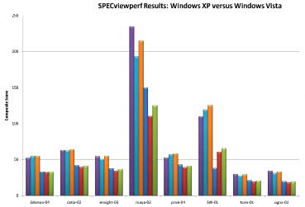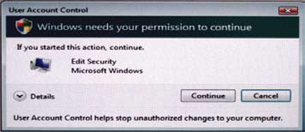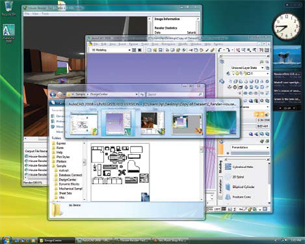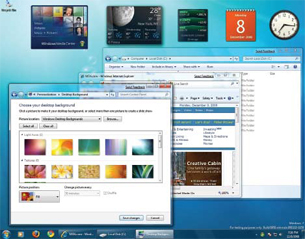Latest News
December 4, 2001
By David Cohn
 Figure 1: Graphic benchmark results using SPECviewperf, comparing Windows XP and Windows Vista. |
Much has been written about Windows Vista since the operating system was first released at the end of 2006—much of it unfavorable in terms of performance. Early adopters reported significant speed degradation, particularly when running CAD applications. Some programs needed to be patched or required entirely new versions. Peripherals lacked drivers.
But those were the early days. Now that we’ve gained some experience (and almost all new systems come with Vista pre-installed), we felt it was high time to take a more in-depth look at the operating system and its likely impact on DE readers.
Performance Differencesare Largely Gone
When it first arrived, Vista was sluggish compared to XP, largely for three reasons.
• Incompatible Software: Applications performed slowly (if at all) because they weren’t designed to run under Vista. But most applications are now Vista compliant if not fully certified for Windows Vista. Of course, you may need to buy a new version of the software.
• Glass gets in the way: Microsoft surely had many reasons to change the appearance of its operating system—unflattering comparisons to the Mac OS come to mind. Like it or not, Vista’s Aero interface is more than skin deep. Most Aero features such as transparent windows, animated icons, and application preview are the result of its underlying Desktop Window Manager (DMW) architecture. According to Ian Williams, senior applied engineer at NVIDIA and chair of the SPECopc project group (the developers of the Viewperf benchmark), “Because Aero is tightly integrated with the GPU, it is essentially a complete 3D application in itself, using much of the GPU’s capabilities and horsepower.”
|
Aero actually competes with other applications for GPU resources. When enabled, all OpenGL and DirectX content passes through the DWM. This frees the CPU for other things, but exerts a penalty on graphics-intensive applications.
You can disable much of the DMW by switching to the Windows Classic theme. In our tests, we found that doing so results in modest performance improvements. But since this also disables the best features of Aero, users will likely keep Aero enabled.
• Baby Drivers: Much of the graphic performance we’ve come to expect under Windows XP has resulted from years of improvement in each release of the driver software used by our graphics cards. When Vista first shipped, those drivers were essentially back at square one. But since then, programmers have made great strides in optimizing those video drivers to extract the same kind of performance from Vista that we’ve long expected under XP.
To prove this, we ran the SPECviewperf graphic benchmark on identical systems under Windows XP and Windows Vista, the only change being the operating system. HP graciously sent us an HP xw8600 tower and HP EliteBook 8530w mobile workstation, both with separate hard drives. By simply swapping drives, we could easily compare the two operating systems while everything else (memory, graphics boards, etc.) remained the same.
The results were quite surprising. Using the most recent certified video drivers for the NVIDIA graphics boards in our HP test systems, the performance differences between Windows XP and Windows Vista were so small as to be, in our opinion, insignificant to users. In fact, on some of the Viewperf datasets, graphic performance was actually faster using Vista than XP. The difference with Aero enabled or disabled was also minimal. These results are illustrated in the accompanying graph.
|
That’s not to say that Vista is completely equal to XP. It took AutoCAD a few seconds longer to render under Vista and XP (a 2 percent difference). And our HP laptop consistently ran longer on our battery run-down test under Windows XP than Windows Vista—3:20 under XP compared to 3:00 under Vista.
Vista has been referred to as “bloated.” But the bottom line in our opinion is that if you’ve got a modern, multicore system with an appropriate amount of memory and the latest versions of your video drivers and application software, Vista performs just as fast as XP. Regardless of which operating system you use, you should periodically update your system to the latest certified video driver.
Other Vista Concerns
But what about Vista’s other issues? Vista’s user rights management (UAM) system is meant to protect the computer from malicious or inadvertent corruption, yet Vista isn’t much more secure than XP. The UAM is just more in your face than similar protections in XP. It pops up every time you attempt to install new software or change OS settings. We had to disable some of its functions just to be able to run our benchmarks, which was frustrating.
Vista’s new interface definitely takes some getting used to. Familiar controls have been moved, others renamed. Some of Vista’s enhancements, such as desktop search, can be added to XP. But I like the Aero Glass interface and other features, such as the new Start menu, the improved Explorer window, and the task switcher, which shows live thumbnails of applications rather than just icons, and they do aid productivity.
In spite of Microsoft’s intentions, manageability isn’t significantly improved under Vista and its reliability isn’t any greater than Windows XP with the latest service packs. I do like the Vista sidebar, with the ability to add handy applets (Gadgets). But you can add similar features in XP by downloading Yahoo Widgets or Google Desktop.
|
Overall, the majority of users have stayed with Windows XP, but the reasons for not switching to Vista are now largely unwarranted. If you’re already running Windows XP, there is no compelling reason to upgrade your current system to Vista. But if you’re buying a new system, there’s no reason not to get Vista unless you know that some of the software you want to run is not Vista certified.
Bits and Cores
Regardless of your choice of operating system, you may need to make a different decision—such as whether to shift from your current 32-bit operating system to a 64-bit version. Such a change does involve installing a new OS, so why would you want to switch?
The 32-bit versions of Windows XP and Vista can use no more than 4GB of RAM whereas the 64-bit versions can use up to 128GB of memory. If you think big—parts with more than 1,000 features; assemblies of 10,000 or more components—you should switch. Of course, a 64-bit OS is only an option if your software of choice is available in a 64-bit version and you install extra RAM. Moving to a 64-bit OS won’t make your software run faster, but it can mean the difference in being able to run it at all when your models get really big.
If you are shopping for a new computer, new multicore CPUs offer a true return on investment. The newest multicore CPUs are less expensive than last year’s models and will indeed improve productivity.
The Next Windows Your choices today are between Windows XP and Windows Vista. But what does the future hold? Microsoft is hard at work on Windows 7 (formerly codenamed “Blackcomb” and “Vienna”). A pre-beta release was delivered to developers in late October 2008 and the first Windows 7 Beta DVDs were to be distributed to attendees of the Microsoft Developer Conference in January with plans to release the final build of Windows 7 sometime between June 2009 and July 2010. Windows 7 is intended to be an incremental upgrade, providing complete compatibility with existing device drivers, applications, and hardware. Presentations given by Microsoft this past year have focused on multi-touch support, a new home networking system and performance improvements, particularly on multi-core processors. So should you wait for the next release of Windows? You need an operating system today to run the applications you’re currently using or plan to acquire. We’ll consider Windows 7 when the time comes. |
Most CAD applications are only minimally multithreaded; they don’t take much advantage of multiple CPU cores. But even if you run only single-threaded apps, you’ll benefit from multiple cores. That’s because few of us run just one program at a time. Most people keep e-mail and a few other applications active and anyone not running full-time anti-virus software is just looking for trouble. With today’s multicore processors, you no longer need to share compute cycles. Your CAD software gets the attention of one CPU core while all that other stuff runs on another core. And best of all, you don’t have to think about it; the operating system does this for you. Windows XP does a pretty good job of dividing things up, Vista is better, and the next release of Windows is expected to be fine-tuned for multitasking (see sidebar).
When you do run multithreaded applications—such as finite element or computational fluid dynamics analysis, rendering applications, or even image editing software—the application splits all those computations across the available CPU cores. The speed improvement here is obvious; just look at the results from our standard AutoCAD rendering test. An image that took eight minutes to render on a single CPU takes just four minutes on a system with a dual-core CPU, two minutes on a quad-core, and a mere 30 seconds on a system equipped with a pair of quad-core processors (the equivalent of having eight separate CPUs).
Go Shopping
Armed with answers, you should be better prepared now to make your 2009 computing decisions. Unless you’re in the market for a new computer, keep the operating system you already have, unless it makes sense to move to a 64-bit OS. If you’ve put off buying a new machine, stop waiting. Use our reviews as a guide. Either way, you’re now better prepared to decide which operating system is for you.
More Info
Microsoft Corp.
Redmond, WA
Contributing Editor David Cohn is a computer consultant and technical writer based in Bellingham, WA, and has been benchmarking PCs since 1984. He’s the former Editor-in-Chief of Engineering Automation Report and CADCAMNet, and the author of more than a dozen books. Please send comments about this article to [email protected]. You can also contact David at [email protected].
Subscribe to our FREE magazine, FREE email newsletters or both!
Latest News
About the Author
David Cohn is a consultant and technical writer based in Bellingham, WA, and has been benchmarking PCs since 1984. He is a Contributing Editor to Digital Engineering, the former senior content manager at 4D Technologies, and the author of more than a dozen books. Email at [email protected] or visit his website at www.dscohn.com.
Follow DE








